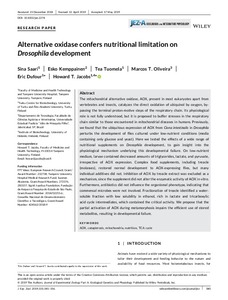Alternative oxidase confers nutritional limitation on Drosophila development
Saari S.; Kemppainen E.; Tuomela T.; Oliveira M.; Dufour E.; Jacobs H.
https://urn.fi/URN:NBN:fi-fe2021042823137
Tiivistelmä
The mitochondrial alternative oxidase, AOX, present in most eukaryotes apart from vertebrates and insects, catalyzes the direct oxidation of ubiquinol by oxygen, by‐passing the terminal proton‐motive steps of the respiratory chain. Its physiological role is not fully understood, but it is proposed to buffer stresses in the respiratory chain similar to those encountered in mitochondrial diseases in humans. Previously, we found that the ubiquitous expression of AOX from Ciona intestinalis in Drosophila perturbs the development of flies cultured under low‐nutrient conditions (media containing only glucose and yeast). Here we tested the effects of a wide range of nutritional supplements on Drosophila development, to gain insight into the physiological mechanism underlying this developmental failure. On low‐nutrient medium, larvae contained decreased amounts of triglycerides, lactate, and pyruvate, irrespective of AOX expression. Complex food supplements, including treacle (molasses), restored normal development to AOX‐expressing flies, but many individual additives did not. Inhibition of AOX by treacle extract was excluded as a mechanism, since the supplement did not alter the enzymatic activity of AOX in vitro. Furthermore, antibiotics did not influence the organismal phenotype, indicating that commensal microbes were not involved. Fractionation of treacle identified a water‐soluble fraction with low solubility in ethanol, rich in lactate and tricarboxylic acid cycle intermediates, which contained the critical activity. We propose that the partial activation of AOX during metamorphosis impairs the efficient use of stored metabolites, resulting in developmental failure.
Kokoelmat
- Rinnakkaistallenteet [27094]
